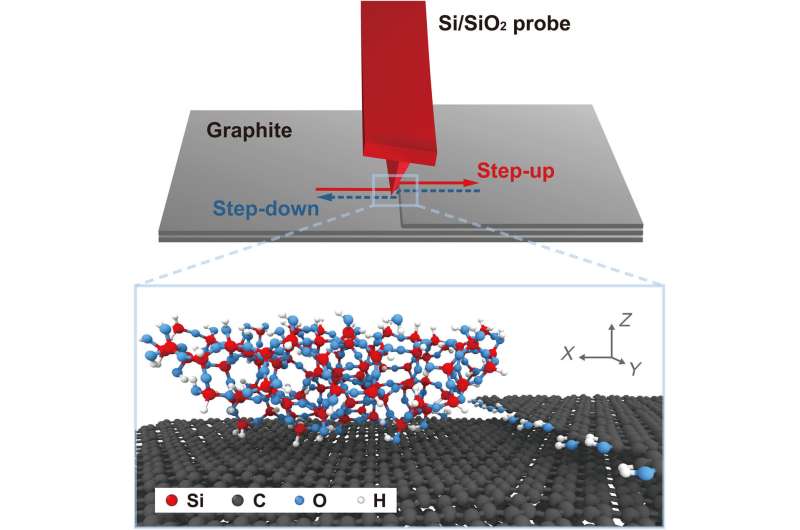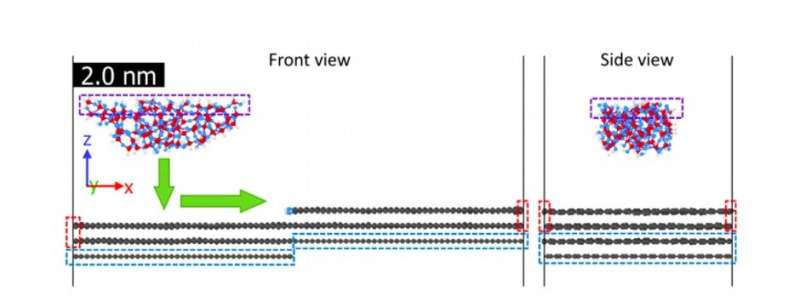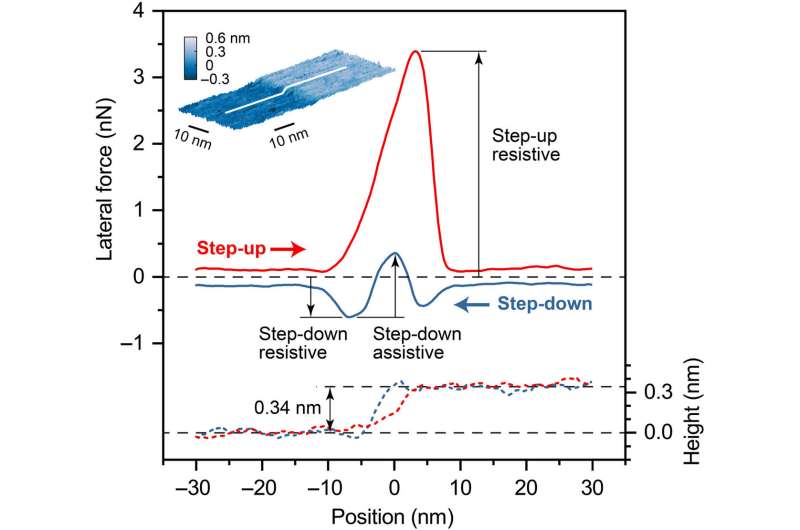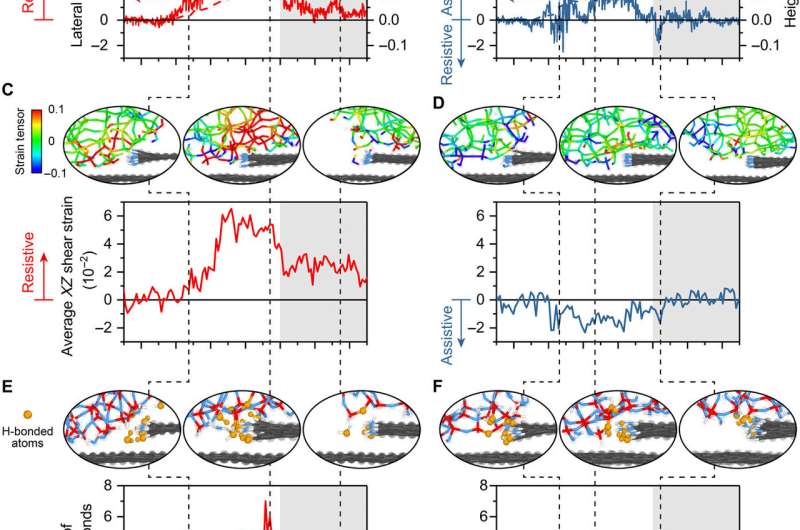August 19, 2019 feature
Chemical and physical origins of friction on surfaces with atomic steps

Friction results from a set of complex processes that act together to resist relative motion. Despite this complexity, friction is often described using simple phenomenological expressions that relate normal and lateral forces via the friction coefficient. The defined parameter encompasses multiple, sometimes competing effects. To better understand the origins of friction, Zhe Chen and an interdisciplinary team of researchers in the departments of chemical engineering, mechanical engineering and materials research studied a chemically and topographically well-defined interface between silica and graphite using a single-layer graphene step edge setup.
The research team identified the separate contributions of physical and chemical processes to friction and showed that a single friction coefficient could be separated into two terms corresponding to these effects. The results provided insight into the chemical and topographic origins of friction as an avenue of tuning surfaces by leveraging competing frictional processes. The findings are now published on Science Advances.
Friction occurs at the interface between any two solid surfaces in contact and moving at different speeds or directions. Since friction can correspond to wasted energy, scientists use the parameter to determine the efficiency and useful lifetime of all moving systems from biological to the aeronautical. Frictional force (Ff) is often linearly proportional to the applied load (L) at the microscale and the proportionality of this relationship, known as the coefficient of friction (COF) is symbolized by µ and expressed as Amonton's Law.
Adhesive forces (Fa) can become significant at the nanoscale to introduce an additional term for molecular mechanisms of tribology in thin films. While the expression is phenomenologically simple and has held value in experiments for decades, the actual mechanisms of determining the magnitude of the COF are very complicated. Physicists had previously proposed friction to have purely physical origins with related chemical processes to occur in sliding surfaces. But the interplay in the observed friction is thus far only poorly understood, since friction is typically associated with surface wear alone. In the present work, therefore, Chen et al. used a chemically and topographically well-defined interface to identify the contributions of physical and chemical processes to friction without accounting for surface wear to obtain fundamental insights into the origin of the frequently reported but poorly understood COF (coefficient of friction).

The scientists used a model system containing an atomic force microscopy (AFM) probe made of silicon referred to as a silica tip, and a graphite surface with a single-layer graphene step edge. The basal plane of graphite provided a chemically inert and defect-free flat surface. The exposed graphene sheet at the top was proportionate to the underlying layer, providing a topographically least corrugated surface for friction tests. The experimental system contained a single-layer graphene step edge on the graphite surface, to provide a well-defined topography with a height change of 0.34 nm across a distance corresponding to one chemical bond length to form an atomic step. The research team modelled the same system using reactive molecular dynamics (MD) simulations, recreating the apex of the silica tip on the topmost layers of graphene in the graphite, close to the step edge. They allowed for computational and experimental studies of the interfacial shear of a silica surface on an atomically flat surface, and on a chemically or topographically well-defined feature at the step, during the study. The experimental model agreed with the computational simulation to provide insight into the atomic-level origins of friction.

During measurements of the graphene step edge with a silica AFM tip, the research team obtained a COF of about 0.1, close to the value observed on various surfaces under elastic deformation tests. During step-down in the AFM tip based setup, Chen et al. observed more complicated friction responses in which the friction fluctuated during topographic height changes. The observed changes did not correspond to topography alone, but the team could not differentiate the chemical and physical effects in the system. To explore these origins, they analyzed friction as a function of load and observed load dependence of friction on the graphite terrace and at the graphene step edge from both experimental studies and simulations. The results confirmed that the simulations provided atomic insights into the interfacial processes of complex friction behaviors. They quantified the COF in the system with load bearing friction to isolate the chemical and physical contributions. The research team used the atomic-scale information observed in the simulations for additional insight.
To quantify physical contributions to friction in the reactive MD simulation, the scientists first used the shear strain of the silica tip. They then quantified the chemical contributions using the number of hydrogen bonds formed between the silica tip and graphite surface during the experiment. They did not observe significant physical or chemical interactions when the silica tip slid across the graphite basal plane, which they used to explain the experimental superlubricity of COF calculated (~0.003) in the study. However, during atomic step-up, the physical (strain) and chemical (hydrogen bonding) mechanisms synergistically enhanced resistance to sliding, causing the COF to become 100 folds greater at atomic step-up than at the basal plane of graphite. The scientists recorded similar observations for the step-down resistive force due to hydrogen bonding interactions.

In this way, Zhe Chen and co-workers used COFs and MD simulations together, to provide insight into the physical and chemical origins of friction. They achieved superlubricity in the experimental setup when the strain induced by the topography and interlocking, as well as chemical bonding at the shear plane were negligible. The team observed large friction in the setup when the step-up above the 0.34 nm high graphene step edge caused combined physical effects from topography and chemical effects due to interfacial bonding. During step-down motion in the experiments, the negative topography change produced a force to assist sliding motion, while the chemical bonds between the oppositely moving surfaces produced a resistive force. The research team showed that balancing these two components could determine if the friction and the COF in an experimental system were ultimately positive or negative.

The results explained the difficulty of achieving superlubricity on atomically rough surfaces—unless the topographic surface features were chemically inert. In total, the findings suggest the possibility of tuning the COF with prescribed topographic features and prearranged chemical groups. While the concept does not immediately improve industrial applications of friction, it provides fundamental insight to the chemical and topographic origins of friction and therefore holds significant promise for future scientific advances on minimizing resistance at tribological interfaces. Chen et al. envision the work will open possibilities of tunable friction in applied physics.
More information: Zhe Chen et al. Chemical and physical origins of friction on surfaces with atomic steps, Science Advances (2019). DOI: 10.1126/sciadv.aaw0513
Kaiwen Tian et al. Load and Time Dependence of Interfacial Chemical Bond-Induced Friction at the Nanoscale, Physical Review Letters (2017). DOI: 10.1103/PhysRevLett.118.076103
D. Berman et al. Macroscale superlubricity enabled by graphene nanoscroll formation, Science (2015). DOI: 10.1126/science.1262024
Thomas P Senftle et al. The ReaxFF reactive force-field: development, applications and future directions, npj Computational Materials (2016). DOI: 10.1038/npjcompumats.2015.11
Journal information: Science Advances , Physical Review Letters , Science
© 2019 Science X Network



















